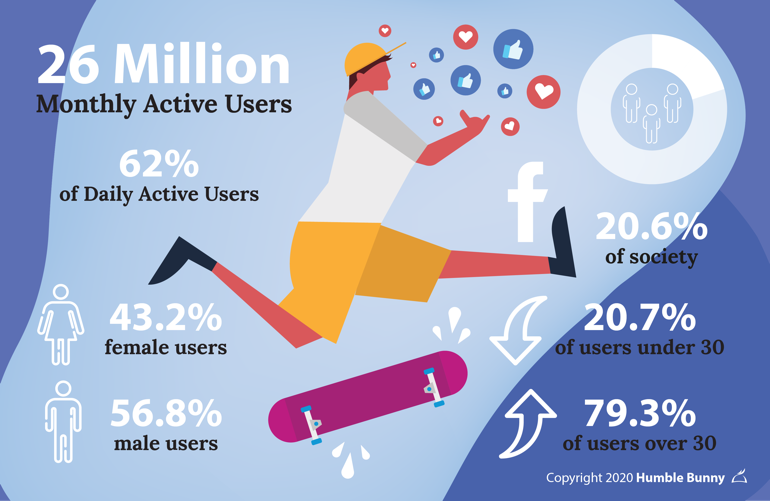The journey inbound businesses need to undertake when entering Japan is more complex than ever. Between search, social, content, email, PR, podcasts, and everything else, users are interacting with brands across multiple fronts.
Despite so much choice, it remains that one of the most reliable and effective ways brands choose to target their new audiences today is Facebook Advertising. And we’ve seen many successful campaigns drive serious brand awareness and conversions in the Japanese market using this approach.
Yet, many have also failed to make the most of the platform has to offer, and have fallen into some common traps. So in this blog, we explore some of the most crucial mistakes you need to avoid if you want to achieve success with your Japanese Facebook ads.
Need Help Building Your Japanese PPC Strategy?
1. Not Understanding Your Audience

Understanding your audience is certainly not a new concept. But some brands simply lose sight of the fundamentals when entering Japan. Why? We’re not entirely sure.
Perhaps because the task of getting to know a completely new consumer culture is overwhelming, or, maybe businesses owners wrongly assume that Japan’s homogeneous characteristics mean everyone should be marketed to in the same way.
Whatever the case, remind yourself that a good grasp of your audience is a cornerstone of effective Facebook advertising. Without detailed knowledge of your target market to help you tailor and optimize your ads for greater impact, the natural chance of you losing money with a wasted PPC budget is extremely high (and further compounded when you’re operating in Japan).
Even if your product appeals to a wide audience, people expect a higher level of personalisation today through the ads and content they receive. You won’t be able to get away with generic marketing content aimed at the masses. A great deal of segmentation and unique creative ads tailored to your buyer personas is the only way you’re going to see some real progress.
Missing Out on Seasonal Opportunities
With four distinct seasons in Japan, the ‘seasonal theme’ in marketing is a key strategy. Campaigns and even new products are launched every season, sometimes for a short, limited time only to boost higher engagement and conversions during specific events, holidays and seasons.
Having an awareness of seasonal marketing potential, and beyond this, the kind of specific holidays and events your target audience are most likely to care about, will enhance any Facebook ads campaign.
If you’re trying to convince Japanese users that you’re committed to the local culture, there’s no better way than to leverage large social events such as seasonal trends or festivals into your marketing strategy.
HB Pro Tip: Including a seasonal discount or a “holiday special” for something like Golden Week for example is an easy and effective way to increase your CTR and conversions with your Japanese PPC ads. This is a great way to stand out and show users that you’re more than just a foreign brand trying to capitalize on the Japanese consumer market.
Underestimating Age Considerations

Facebook as a platform caters more to older demographics. And age in general is very important in Japan. As well as a genuine respect for the elderly and a positive treatment of older individuals in advertisements and marketing, the proportion of older people making up the Japanese population is rising.
Many aspects of Japanese life are also determined by age, including purchasing power. Typically, salaries are directly connected to age, with older more senior employees enjoying a higher income than their juniors.
All these things are important for understanding how to position your brand in the market and create content for your Facebook ads that connects with the right demographic segment.
HB Pro Tip: Without an understanding of your Japanese target audience, you won’t be able to factor in the unique buying cycles and behaviours of that group. If you are targeting retired seniors for example, you should be creating an ad strategy around their likely behaviour and interests, such as what kind of content this group is likely to enjoy when they encounter your Japanese Facebook ads.
2. Targeting too Broadly with Japanese Facebook Ads

If you don’t have a clear idea about your audience and target too broadly with your Japanese Facebook ads, you’ll never reach your true potential. This is one of the easiest ways to burn through your advertising budget and see very little reward.
Broad Audience Targeting vs. Custom Audiences
If you advertise on Facebook, it’s crucial to look at how to optimize your campaigns for different customer segments within the platform. Facebook lets you create custom audiences based on your website visitors, customer list, and user engagement. And there’s absolutely no reason you shouldn’t be doing this!
Letting the platform use its own methods and algorithms to find the best people to show your ads to, through a broad targeting approach, is good if you’re not sure which people you want to reach. Or for learning about new demographics who are responsive to your content.
However, at some point you will want to refine your targeting based on the optimal audience groups. Using custom audiences is the best way to do this.
Some ways to introduce custom audiences into your Japanese Facebook ad campaigns include:
- Uploading a list of current customers
- Base an audience on website visitors (and specific user behaviour)
- Generate an audience based on social engagement
3. Poor Campaign Structuring

PPC marketing campaigns need organization. So much goes into a winning Facebook ads campaign, and not properly organizing each account, ad group and messaging pillar can undo all of the good work and effort you put into setting up your strategy.
Depending on your platform of your choice, your basic account structure should include some of the following core elements: campaigns, ad groups, ad copy, and visual assets. Arranging these elements into a logical, easy-to-track structure ultimately helps you to control where your budget goes and how to achieve the best results with your Japanese Facebook ads.
Improve Your Reporting
Having logically structured accounts and ad groups will allow for better reporting too, which will help you to make optimization changes and important decisions about your future strategy.
If your campaign structures are too loose, or lack appropriate naming conventions to represent the different aspects of your strategy, your activities can become muddled quickly – especially if you’re running campaigns across multiple platforms.
Want to Learn More About Structure Your Next PPC Campaign?
4. Not Considering Alternatives to Japanese Facebook Ads

The right Japanese PPC platforms can make a huge difference for your goals. And while Japanese Facebook ads have helped many businesses achieve amazing results when entering the Japanese market, it’s not the only platform you should be considering.
If your brand has a great campaign running for a specific audience in your home market, it doesn’t mean you can migrate the same campaign approach to Japan, as the demographic considerations for each SNS platform will be different.
Moreover, a great overall digital marketing strategy for your brand may well involve a multi-platform approach that takes advantage of more than one of Japan’s most popular channels. For example, if a large percentage of your target audience are known to frequent Line, one of the biggest SNS platforms in the country, this may be a good place to dedicate some of your marketing spend.
HB Pro Tip: There are different platforms for different needs, including brand awareness, consideration, and immediate sales. For instance, Instagram is an increasingly popular place for fashion brands to generate direct sales through captivating product-focused content aimed at niche demographics.
Popular SNS Platforms in Japan
Sources: Insta Lab
5. Spreading Yourself Too Thinly
Starting small and scaling up is often a better way to start than pushing hard on all fronts when you’re getting started in Japan.
Familiarising yourself with your audience demographics and platforms while building the right framework for constant testing and optimization should be given sufficient time to get right. Often, mistakes are made when you try to handle too many things at the same time.
With limited resources, it is more effective to have 1 or 2 highly successful campaigns that you can learn from and expand, rather than 5 which yield meagre results and give you very little to grow from. This could mean targeting only your core service or product at the start, or prioritising a select number of creative messaging pillars to test. With a deeper insight into what works, you can scale up your efforts with greater confidence.
Starting small and scaling up is often a better way to start than pushing hard on all fronts when you’re getting started in Japan.
6. Not Using Targeted Landing Pages

You shouldn’t be sending all your traffic to your homepage. You should have different landing pages for the different campaigns that you have on your account to improve chances of conversion and lead generation and to make an efficient spend in budget as well as be able to measure success and optimise.
Matching Your Ads to Your Landing Pages
Landing page should be highly relevant to the ad copy and visual imagery that triggered that users have chosen to engage with. When a user views your ad, and if their expectations are not immediately met when they land on your site, they’ll quickly bounce. And this is a wasted opportunity.
Qualities of a good landing page include:
- Relevance to marketing copy and keywords
- Helpful and informative content that users want to know about (more information is better than less in Japan!)
- Clear CTAs leading to the next stage of the user journey
- Appealing visuals and design scheme with smooth navigation and layout
- Content that is 100% localized (not just translated from English)
Learn More About Japanese Web Design Trends
7. Not Experimenting Enough
While going too broad is bad, having an approach that’s too narrow is also bad. For example, not using enough ad variations or creative angles can stunt the growth of your overall Japanese Facebook ads strategy.
Even if you find some decent success by launching just one ad per group, you will never know if a different ad or creative angle can get you better results. This will then prevent your next iteration from being even more powerful at reaching your audience and achieving your PPC goals.
With some logical testing and ad variations, with at least 3 ads per group or theme, you’ll get a much more accurate picture of performance and some signals for how you should optimize your campaigns going forward.
When testing between variations, make sure you are testing between them evenly to give each ad a fair chance to be shown. After your first reporting period, you will be able to judge the result accurately and tweak your approach.
HB Pro Tip: Facebook ads are extremely visual compared to other types of PPC ads, such as Google, which relies more on keywords and ad copy. Therefore, it is a great occasion to reinforce your branding and communication strategy with some high quality graphics worked up by a designer who understands the preferences of the Japanese consumer.
Discover the Best Ad Types for Converting Users on Facebook
8. Not Building a Complementary SEO Strategy

Japanese Facebook ads (and PPC in general) is great for generating short-term gains that are especially important when first starting out in the Japanese market. But, this isn’t cost effective in the long-run if you’re constantly paying for your online traffic.
A complementary content marketing and SEO strategy executed with consistent quality through content campaigns will help you to develop a loyal and engaged customer base and start generating organic traffic (which is free).
Trying to Decide Between Japanese PPC and SEO? Here’s Some Advice
9. Not Tracking and Testing Enough
Firstly, without being able to accurately measure conversions, it is impossible to optimise your PPC campaigns for strong return on investment. If you don’t have conversion tracking set up and a way to benchmark your progress, then it becomes impossible to judge how well a specific ad, visual, keyword, or overall campaign is performing.
Secondly, not using the data you have available to you in order to constantly test and improve ways of maximising your potential is… silly. Even if you’re running successful campaigns, they can always be better. It’s not just poor performing campaigns that need optimizing, it’s also ones which are doing well.
Finally, the learnings you achieve from tracking and testing your Facebook ads thoroughly can often be applied to other marketing channels. The new knowledge about your audience can help you to build a more comprehensive buyer persona that translates to many other areas of your business (and may even be useful during product and service development processes).
Important components to test
- Ad copy and messaging pillars
- Landing pages
- Audience targeting
- Ad delivery windows
- Visual ad variations
Does It Work?
At Humble Bunny, it’s been our culture of constantly experimenting, tracking, testing, and optimizing that has been our key to success for many of our PPC campaigns.
When we worked with the luxury fashion brand for example, our performance highlights included boosting ad recall lift by as much as 91.16% on average, over the first 3 months.
While this was partially supported by a strong market research phase and diligent account management, it was tracking and testing that helped us to achieve our results as much as anything.
10. Not Keeping It Fresh
Content often has a limited lifespan. When you promote the same content to the same audiences for too long, you’ll typically start to see any positive results diminish. This kind of fatigue is frustrating when you think you’ve finally got a good thing going, but it’s a reality you must face.
Sometimes, to keep things new, you need to implement a refresh to make sure your assets aren’t too static or boring. And this is why constantly testing is so beneficial. With an approach that is always dynamic, you’ll be able to draw from a greater body of data to find innovative and creative ways to reach your audience and keep them interested.
Final Considerations for Japanese Facebook Ads
There are more than a few pitfalls new brands entering Japan succumb to. But many mistakes can be avoided if you prevent your strategy from being one dimensional, or based on too many assumptions.
As long as you establish the right framework within your Facebook ads strategy, involving creativity, testing, accurate reporting, and constant optimizing, there’s no reason you can’t see some great results with your PPC strategy.
Facebook advertising is still one of the most powerful tools at your disposal. And as long as you’re not overlooking the potential errors that could be made, you should be able to achieve some significant results with ad campaigns launched on this platform.